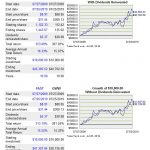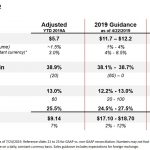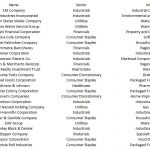Contents
W.W. Grainger, Inc. released Q2 2019 results and FY2019 on July 24, 2019. Despite softer demand and lowered Sales guidance, management has reiterated Gross Profit Margin, Operating Margin, and adjusted diluted EPS guidance.
Summary
- GWW reported Q2 results on July 24th. Gross and Operating Margins and adjusted EPS guidance have been maintained but sales guidance has been lowered.
- Management discussed headwinds on the Q2 analyst call but initiatives recently put in place, or in the process of being implemented, should improve GWW’s competitive advantages over the long-term.
- Despite projected sales headwinds investors have bid up GWW’s share price ~17% in the past 2 weeks.
- GWW is but 3 years away from qualifying for the honor of being in the exclusive Dividend King group of companies (50 consecutive years of dividend increases).
NOTE: In this article I provide my opinion on W.W. Grainger, Inc.’s (GWW) valuation and present a potential conservative option strategy which can be employed if you own the underlying shares and reach a similar opinion as me regarding GWW’s current valuation and short-term stock price outlook.
Before investing in any company it is wise to familiarize yourself with the company. In this regard, I provide this link to GWW’s 2019 Fact Book.
Introduction
In my recent Fastenal Company (FAST) article I looked at one Wholesale Industrial Equipment industry participant in which I currently do not hold a position.
I now look at GWW, a company in which I initiated a position on October 16, 2018 for one of the ‘side accounts’ within the FFJ Portfolio and for which I wrote this article.
In my January 24, 2019 GWW article, at which time shares were trading at $286.22, I wrote that I viewed shares as being a tad expensive.
Subsequent to my January article, GWW retraced to the upper $250 – lower $260 range in late May and early July. Despite my intent to acquire additional shares at the time I wrote my January article, I did not add to my GWW position because my outlook on the broad North American market had turned decidedly more ‘bearish’; I am of the opinion that a broad market pullback will come about before the end of 2019.
In addition, where possible, I try to own shares in an industry’s two largest industry participants. Examples of this include VISA Inc. (V) and Mastercard Incorporated (MA), Automatic Data Processing, Inc. (ADP) and Paychex, Inc. (PAYX), The Coca-Cola Company (KO) and PepsiCo, Inc. (PEP).
GWW is currently the second largest Wholesale Industrial Equipment industry participant from a market capitalization standpoint with FAST being the largest. GWW’s annual revenue, however, is twice that of FAST.
FAST has also rewarded shareholders to a slightly greater extent than GWW over the past 10 years.
Source: Tickertech.com
While my intent is to initiate a FAST position before acquiring additional GWW shares, I still like to see how my existing investment is faring and I also want to learn about management’s business outlook.
Before looking at GWW’s valuation and outlook, let’s quickly look at GWW from a high level.
Business Overview
GWW is one of the largest industrial distributors in North America. As a result, I am of the opinion it benefits from scale-driven cost advantages over smaller competitors in a highly fragmented markets (7% market share in the U.S., 5% in Canada, and 4% global). In fact, much of GWW’s competition comes from smaller local and regional distributors that lack GWW’s scale and global reach.
Looking at GWW’s 2019 Fact Book we see that it has in excess of 450 global branches and 30 distribution centers across the globe. With its scalable distribution network and centralized order fulfillment centers GWW can cost-effectively serve its customer base, including multinational customers that require consistent product availability and service quality around the globe.
In my opinion, GWW has technological capabilities, including its e-commerce sales channel, integrated customer purchasing and inventory management solutions, and warehouse automation from which it can drive distribution efficiencies that make it extremely difficult for smaller competitors to replicate.
Roughly 21% of sales are generated from higher-margin private-label products which have higher profit margins.
In addition, an increasing number of companies have been consolidating their spending with large national distributors. This vendor consolidation allows customers to simplify their procurement processes and leverage their buying power. With its sizable distribution network and robust portfolio of products and valued-added services, GWW is well-positioned to capitalize on this trend and to acquire marketshare from its smaller local and regional competitors.
While national accounts typically generate lower gross profit margins, the volumes are much higher and thus GWW should be able to improve operating margins.
Q2 2019 Results and FY2019 Guidance
GWW’s results and guidance can be found here and the accompanying Earnings Presentation can be found here.
Source: GWW – Q2 2019 Earnings Call – July, 2019
Having read GWW’s Q2 2019 Earnings Release, reviewed the accompanying Q2 Earnings Presentation, read the transcript of the analyst call, and looked at the behavior of GWW’s stock price, I admit that I am puzzled.
GWW’s Chairman and CEO remarked on the July 24th Analyst call that:
‘The demand environment has softened throughout the year.’
‘In times of slower growth, we partner with our customers to lower their cost, which strengthens our relationships.’
‘We're through much of the heavy lifting on our cost takeout initiatives and are now focused squarely on driving profitable growth to our U.S. and endless assortment businesses.’
‘At AGI, the top line recovery has been slower than we anticipated.’
‘At Cromwell…performance has lagged in the short term, resulting from market conditions and our actions in the region.’
‘In the quarter, market growth slowed across all of our end markets with the exception of health care.’
‘Our 2019 total company outlook remains the same for gross profit margins, operating margin and EPS based on our strong operating performance so far this year. We are lowering our estimate for market growth to minus 1% to 2% and lowering our revenue guidance to 2% to 5% growth due to the weaker demand environment and performance at AGI and Cromwell.’
Despite lower sales guidance and the increasing risk of a broad market snapback, GWW’s share price has jumped from ~$258 on July 10th to the current ~$300. This is a ~16% increase in ~2 weeks!
You can see from the Earnings Release that GWW’s Gross Profit Margin was weaker than that in Q2 2018 but its Operating Margin improved relative to Q2 2018.
We also see that reported EPS of $4.67 in Q2 increased 12% from the $4.16 reported in Q2 2018 and adjusted Q2 EPS of $4.64 increased 6% from $4.37 in Q2 2018. Management attributes this improvement primarily to operating earnings growth and lower average shares outstanding.
In addition, we see that the all important cash flow improved to $0.323B in Q2 2019 versus $0.248B in Q2 2018.
Despite acknowledging a softer demand environment and the lowering of FY2019 sales growth guidance, full-year profit guidance has been reiterated and there is still a commitment to outperform market growth by 3% - 4% over the next several years.
Credit Ratings
Moody’s downgraded GWW’s long-term debt to A3 from A2 on May 8 2018.
S&P Global assigned an A+ rating in April 2017.
As I indicated in my previous article this is a 2 notch difference. Moody’s rating is the lowest tier of the upper medium grade category while S&P’s rating is the top tier of the upper medium grade category.
Both ratings are investment grade and are satisfactory for my purposes.
Valuation
At the time of my October 16th article, GWW had just released results for the 9 months ending September 30th. In that article I determined that on the basis of GWW’s closing stock price of ~$280 on October 16th and a conservative $15.90 adjusted forward diluted EPS for the year, GWW’s forward adjusted diluted PE was ~17.6.
In my January 24, 2019 article I noted that recently released FY2018 results reflected $13.73 in diluted EPS and $16.70 in adjusted diluted EPS. This gave us a diluted PE of ~20.85 and an adjusted diluted PE of ~17.1 based on GWW’s $286.22 January 24th closing stock price.
From a FY2019 guidance perspective, using the $286.22 share price and FY2019 adjusted EPS guidance of $17.10 - $18.70 I arrived at a forward adjusted diluted PE range of ~15.3 - ~16.74.
I indicated that I typically prefer to base my investment decision on GAAP EPS versus non-GAAP EPS (ie. adjusted). GWW, however, provides guidance on a non-GAAP basis so when I conservatively deducted $3/share from guidance (roughly the variance between GAAP and non-GAAP EPS for FY2018) I arrived at an estimated FY2019 GAAP EPS range of $14.10 - $15.70. Using this range and the current stock price, the forward PE range appeared to be ~18.2 - ~20.3 which compared favorably with GWW’s 5 year average GAAP PE of ~21.8.
With guidance remaining unchanged and GWW’s share price having jumped to ~$300 we have a forward adjusted diluted PE of ~16.04 - ~17.54. Using the estimated FY2019 diluted GAAP EPS range of $14.10 - $15.70 which I calculated above we now have a forward diluted PE range of ~19.11 - ~21.28. The valuation has deteriorated slightly subsequent to the time of my January article.
Dividend, Dividend Yield and Dividend Payout Ratio
With a $1.44 quarterly dividend ($5.76/year) and a ~$300 share price, GWW’s dividend yield is ~1.9%. Despite the low dividend yield, I invested in GWW because of its track record of dividend increases.
Following the recent increase in the quarterly dividend ($1.36 increased to $1.44 starting with the June 2, 2019 dividend payment) GWW is only 3 years away from becoming a member of the exclusive Dividend King group of companies.
I also find it acceptable that GWW’s payout ratio is ~36.7% - ~40.85% which is calculated using the forward EPS range $14.10 - $15.70 calculated above.
Covered Call Option Strategy
This strategy is used when you own the underlying shares and you wish to profit from a neutral to bearish price action.
If you use the forward adjusted diluted EPS range and the forward diluted EPS range I provided in the Valuation section of this article then I think a $320 strike price would give you a reasonable level of confidence that GWW’s share price will remain below this level between now and a September 20th option expiry date given the headwinds mentioned by management on the July 24th analyst call.
I have selected a September option expiry since the October option expiry will be too close to the Q3 earnings release and GWW’s share price could experience a sudden last minute spike prior to the release of earnings.
If you to sell September 2019 $320 covered calls you would receive ~$3.10/share or $310/contract before nominal commission.
Let’s look at the possible outcomes using different stock prices.
- If shares are trading below $320 then you retain the premium collected AND your shares. The holder of the right to buy GWW shares at $320 would not exercise their option if they could acquire shares on the open market for less than $320.
- If shares are trading at $321 and the buyer of the calls exercises their right to buy shares from you at $320 then I would be ahead $2.1/share ($321 – ($320 + $3.10)).
- If shares are trading at $323.10 and the buyer of the calls exercises their right to buy shares from you at $320 then you breakeven ($323.10 – ($320 + $3.10)).
- If shares are trading at $330 and the buyer of the calls exercises their right to buy shares from you at $330 then I would be down $6.90/share ($330 – ($320 + $3.10)).
If GWW’ share price exceeds the strike price just prior to expiry and you do not wish to part with your GWW shares, you could buy back the option to close your position. You could then write a new covered call at a higher strike price for a future expiry for which you would receive an option premium that could very well exceed the amount you had to disburse to close your September position.
Final Thoughts
The initiatives recently put in place, or which are in the process of being implemented, should improve GWW’s competitive advantages over the long-term. In the short-term, however, I think GWW faces headwinds AND there also appears to be increasing odds of a pullback in North American equities so I would not be acquiring GWW shares at the ~$300 level. In fact, I am coming across an increasing number of interviews with market strategists who are voicing concern about a snapback in North American equities (even some ‘market bulls’ (here and here) are joining this ‘bearish’ camp).
Earlier in this article I indicated that where possible I try to acquire a position in two key industry participants. Since I already own GWW shares I am leaning toward acquiring shares in FAST once its valuation retraces to what I deem to be an acceptable level.
In addition to viewing GWW as being a tad expensive my decision to acquire FAST shares before increasing my GWW exposure is another reason why I will not be acquiring more GWW shares.
I wish you much success on your journey to financial freedom.
Thanks for reading!
Note: I sincerely appreciate the time you took to read this article. Please send any feedback, corrections, or questions to [email protected].
Disclaimer: I have no knowledge of your individual circumstances and am not providing individualized advice or recommendations. I encourage you not to make any investment decision without conducting your own research and due diligence. You should also consult your financial advisor about your specific situation.
Disclosure: I am long GWW.
I wrote this article myself and it expresses my own opinions. I am not receiving compensation for it and have no business relationship with any company whose stock is mentioned in this article.





